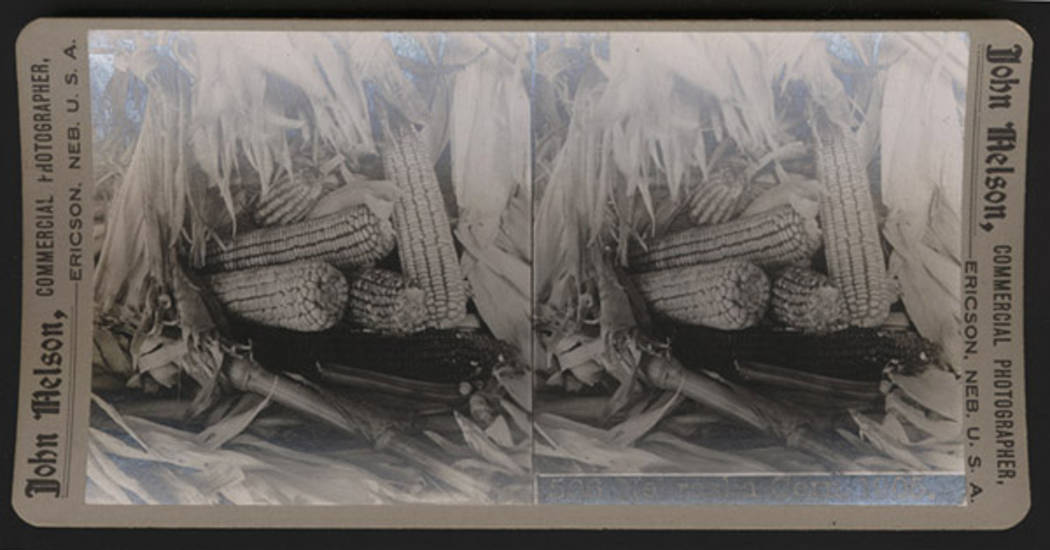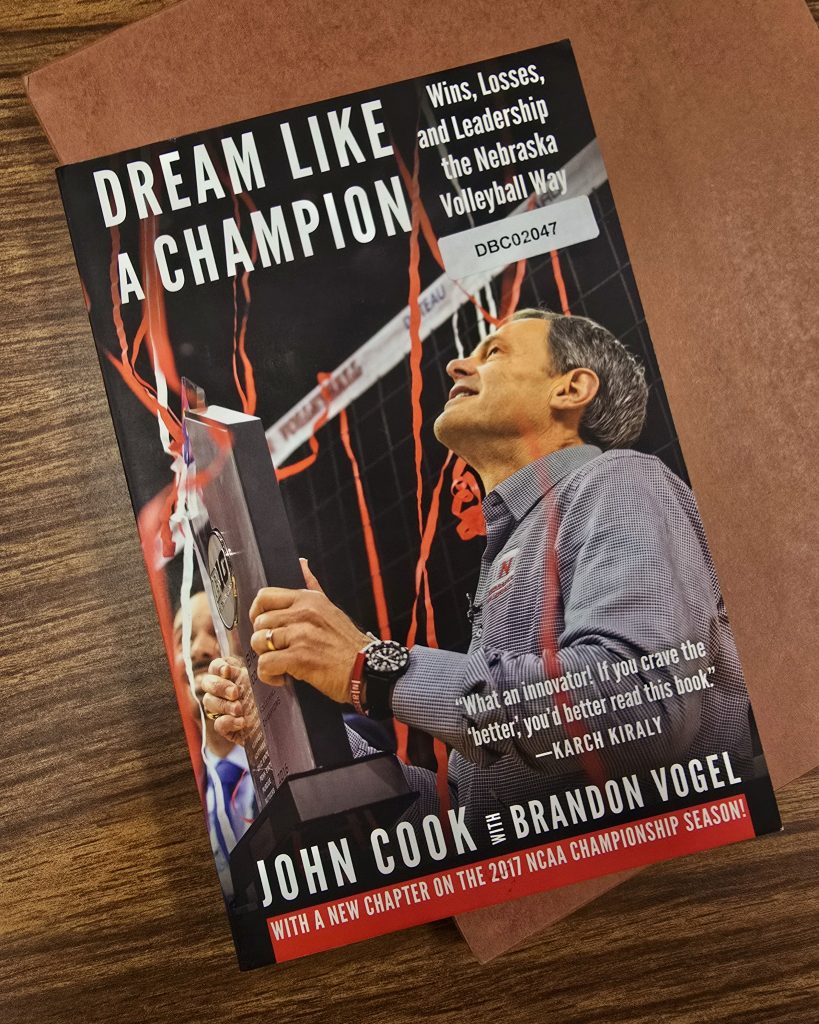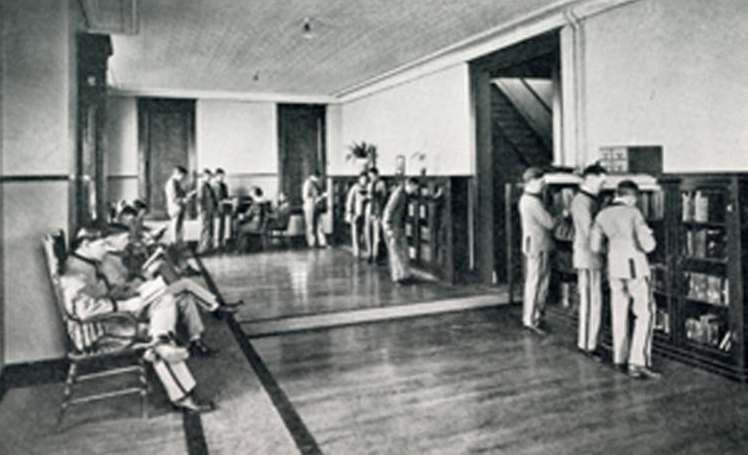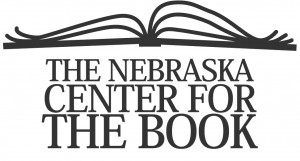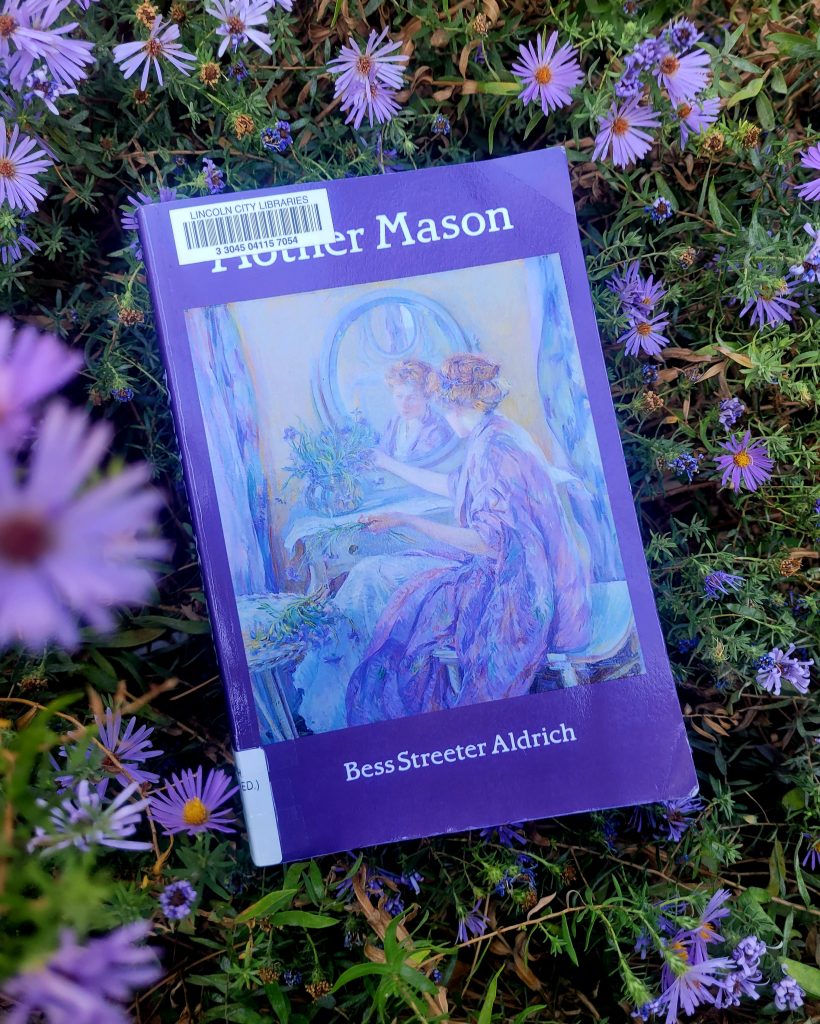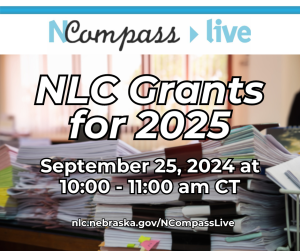Search the Blog
Categories
- Books & Reading
- Broadband Buzz
- Census
- Education & Training
- General
- Grants
- Information Resources
- Library Management
- Nebraska Center for the Book
- Nebraska Memories
- Now hiring @ your library
- Preservation
- Pretty Sweet Tech
- Programming
- Public Library Boards of Trustees
- Public Relations
- Talking Book & Braille Service (TBBS)
- Technology
- Uncategorized
- What's Up Doc / Govdocs
- Youth Services
Archives
Subscribe
Category Archives: General
#BookFaceFriday “A Grim Reaper’s Guide to Catching a Killer” by Maxie Dara
This #BookFaceFriday is a graveyard smash!

This week’s #BookFaceFriday is fully embracing spooky season! Join in with “A Grim Reaper’s Guide to Catching a Killer” by Maxie Dara (Berkley, 2024). This off-beat and humorous murder mystery is the first part in the author’s SCYTHE Mystery Series. It’s available as a an eBook and Audiobook through Nebraska OverDrive Libraries, and can be found in the specially curated collection “Monster Mash,” which is filled with Halloween, monster, or horror themed titles.
“Fun and lighthearted despite the presence of death, the characters are relatable and funny, and the paranormal aspects are balanced with the ordinariness of Kathy’s messy life. The ending fleshes out this creative premise and sets the book up for the next in a heartwarming series.”
— Booklist
Libraries participating in the Nebraska OverDrive Libraries Group currently have access to a shared and growing collection of digital downloadable audiobooks and eBooks. 194 libraries across the state share the Nebraska OverDrive collection of 26,898 audiobooks, 36,794 ebooks, and 5,133 magazines. As an added bonus it includes 130 podcasts that are always available with simultaneous use (SU), as well as SU ebooks and audiobook titles that publishers have made available for a limited time. If you’re a part of it, let your users know about this great title, and if you’re not a member yet, find more information about participating in Nebraska Overdrive Libraries!
Love this #BookFace & reading? We suggest checking out all the titles available for book clubs at http://nlc.nebraska.gov/ref/bookclub. Check out our past #BookFaceFriday photos on the Nebraska Library Commission’s Facebook page!
Throwback Thursday: Nebraska Corn
Have you been to a corn maze this season #ThrowbackThursday?
This black and white stereoscopic photograph is on a postcard, and pictures a close-up of ears of corn. Information printed on item: 506 Nebraska Corn, 1905; John Nelson, Commercial Photographer, Ericson, Neb. U.S.A.
This image is published and owned by the History Nebraska. The collections include material on the history of libraries in the state of Nebraska, items from the 1930s related to the Nebraska Public Library Commission bookmobile, as well as items showcasing the history of Nebraska’s state institutions.
See this collection and many more on the Nebraska Memories archive!
The Nebraska Memories archive is brought to you by the Nebraska Library Commission. If your institution is interested in participating in Nebraska Memories, see http://nlc.nebraska.gov/nebraskamemories/participation.aspx for more information.
Help your library patrons avoid scams with resources from the FTC
The Federal Trade Commission’s latest Consumer Alert is all about how librarians can help their communities recognize, avoid, and report scams: https://consumer.ftc.gov/consumer-alerts/2024/10/help-your-library-patrons-avoid-scams

Their newly-updated website for librarians: https://ftc.gov/libraries provides free reference materials, outreach and programming ideas for all ages, social media “shareables” such images and videos, and handouts including bookmarks and brochures that you can print yourself or order in bulk for free. All resources are in the public domain and can be used without restriction.

They also offer free webinars, and “office hours” for you to drop in and get your questions answered. Upcoming library-related webinars, co-sponsored by the Association of Bookmobile and Outreach Services include:
Wednesday, October 23rd, 11:00AM CST: How to Help Your Library Patrons Avoid Holiday Scams
Thursday, December 5th, 1:00PM CST: How To Bring National Consumer Protection Week to Your Library
Posted in Education & Training, General, Information Resources, Programming
Tagged consumer alert, consumer protection, free resources, ftc, scams
Leave a comment
#BookFaceFriday “Breaking Rank” by Kristin D. Randle
Don’t let this #BookFace strong arm you!

Are your younger readers looking for a great book? Let us lend you a (tiny) hand in finding the right title! The Library Commission has a large collection of book club kits for children and young adults. Like this week’s #BookFace ,”Breaking Rank” by Kristen D. Randle (Turtleback Books, 2001), perfect for readers ages 12 and up; it’s a part of our Book Club Kit collection, with thirteen copies available for checkout. Diving into themes of peer pressure and independent thinking, this novel has been compared to The Outsiders, West Side Story, and Romeo and Juliet.
“This novel challenges stereotypes and stigmas when an unprecedented friendship develops between two teens of rival high school groups. “Randle is adept at conveying ingrained prejudices as well as the frustration and alienation that leads some youths to forsake the `straight’ world for a more friendly and accepting one of their own making.”
—Publishers Weekly
Need a hand searching our collection? Here are some tips! You can browse our collection by genre or grade level, or use a keyword search to find Golden Sower nominees and winners. If you need a large number of books for a whole classroom, limit your search to only those sets with enough books to meet your needs. Still can’t find what you are looking for? Let us know and we’re happy to help.
Book Club Kits Rules for Use
- These kits can be checked out by the librarians of Nebraska libraries and media centers.
- Circulation times are flexible and will be based upon availability. There is no standard check-out time for book club kits.
- Please search the collection to select items you wish to borrow and use the REQUEST THIS KIT icon to borrow items.
- Contact the Information Desk at the Library Commission if you have any questions: by phone: 800/307-2665, or by email: Information Services Team
Love this #BookFace & reading? Check out our past #BookFaceFriday photos on the Nebraska Library Commission’s Facebook page!
Posted in Books & Reading, General, Youth Services
Tagged Banned Books Week, Book Club Kits, Book Covers, bookface, bookfacefriday, Breaking Rank, Kristin Randle, Novel, Reading, YA
Leave a comment
Throwback Thursday: Chief American Horse (Wasicu Tasunke)
We’re celebrating Indigenous Peoples Day this #ThrowbackThursday!
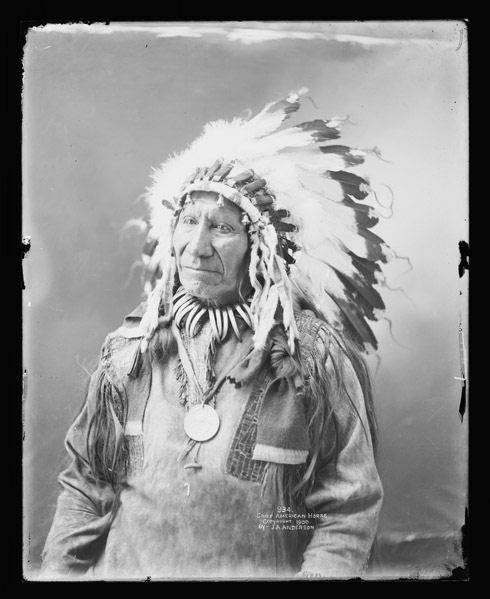
This black and white studio photograph shows Chief American Horse (Wasicu Tasunke) wearing an animal skin shirt and a feathered headdress. He wears both a presidential peace medal and a bear claw necklace around his neck. The photograph was taken at the Rosebud Reservation. During the Ghost Dance Uprising of 1890, American Horse tried to diffuse confrontations between Native Americans and whites. In 1891, he led a delegation of Sioux chiefs to Washington, D.C., to try to bring about better treatment of his people. The Rosebud Sioux Indian Reservation is located nine miles north of Valentine, Nebraska, in South Dakota.
This image is published and owned by the History Nebraska. The collections include material on the history of libraries in the state of Nebraska, items from the 1930s related to the Nebraska Public Library Commission bookmobile, as well as items showcasing the history of Nebraska’s state institutions.
See this collection and many more on the Nebraska Memories archive!
The Nebraska Memories archive is brought to you by the Nebraska Library Commission. If your institution is interested in participating in Nebraska Memories, see http://nlc.nebraska.gov/nebraskamemories/participation.aspx for more information.
NLC Staff: Jo Mezger
Questions and answers with NLC’s newest Talking Book and Braille Reader’s Advisor, Jo Mezger, who started working with us in March 2024. Take a few minutes and get to know them with a few fun questions!
What was the last thing you googled?
What the Crumble Cookies were this week
What’s your ideal vacation?
Has to be good food, no early morning activities, and exactly the weather I planned
What do you do to relax?
Listen to music
Describe your first car?
My current car, a 2012 Toyota Corolla. I just tied the bumper on with zip ties
What was the first concert you remember attending?
Trampled by Turtles
What movie can you watch over and over again?
Akeelah and the Bee
What was the last book you read?
Vashti Bunyan Biography
If you could have one superpower what would it be?
Invisibility
What’s the last thing you do before you got to bed?
Play Stardew Valley video game
If you had a warning label, what would it say?
Recovering people pleaser
What is your favorite comfort food?
Green bean casserole
What words or phrases do you overuse?
(Irrelevantly) “Well, me too”
What’s your most treasured possession?
My cats
On what occasion do you lie?
To keep things private
Do you love or hate rollercoasters?
I’m neutral
Do you have any pets?
5 cats: Cowboy, Moon Face, Papaya, Teemo, and The Commodore
Favorite technology you could not live without?
My electric blanket
If you could get rid of one holiday – which one would you abolish?
The 4th of July
If you could only eat one kind of food for the rest of your life, what would it be?
Pasta
If you could call anyone in the world and have a one-hour conversation, what would you call?
Mariame Kaba
What do you get every time you go to the grocery store?
Can of chickpeas
Posted in General, Public Relations
Tagged Nebraska Library Commission Staff, NLC Staff, Staff
Leave a comment
The Long March Home: A World War II Novel of the Pacific Chosen as 2025 One Book One Nebraska
FOR IMMEDIATE RELEASE:
October 12, 2024
FOR MORE INFORMATION:
Tessa Timperley
402-471-3434
800-307-2665
The Long March Home: A World War II Novel of the Pacific Chosen as 2025 One Book One Nebraska
People across Nebraska are encouraged to read the work of a Nebraskan — and then talk about it with their friends and neighbors. The Long March Home: A World War II Novel of the Pacific (Revell, 2023) by Marcus Brotherton and Tosca Lee is the 2025 One Book One Nebraska selection.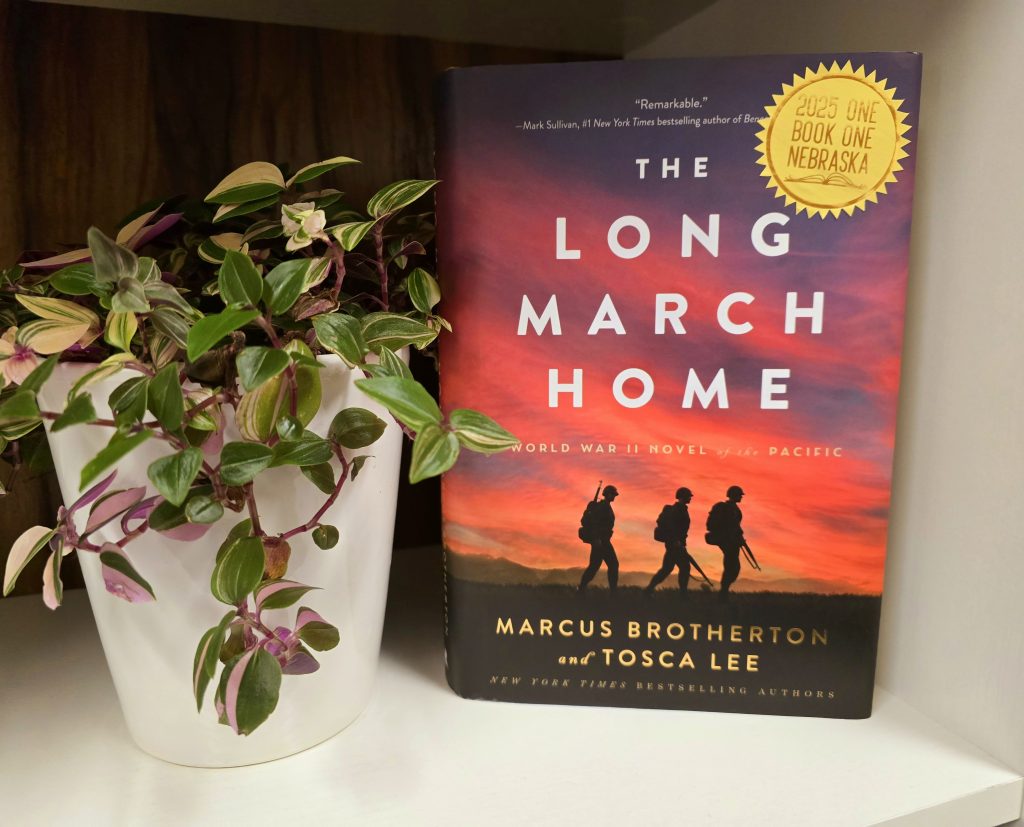
The Long March Home is a historical fiction novel inspired by true stories of friendship, sacrifice, and hope on the Bataan Death March.
From the Inside Cover:
Jimmy Propfield joined the army for two reasons: to get out of Mobile, Alabama, with his best friends Hank and Billy and to forget his high school sweetheart, Claire.
Life in the Philippines seems like paradise–until the morning of December 8, 1941, when news comes from Manila: Imperial Japan has bombed Pearl Harbor. Within hours, the teenage friends are plunged into war as enemy warplanes attack Luzon, beginning a battle for control of the Pacific theater that will culminate with a last stand on the Bataan Peninsula and end with the largest surrender of American troops in history.
What follows will become known as one of the worst atrocities in modern warfare: the Bataan Death March. With no hope of rescue, the three friends vow to make it back home together. But the ordeal is only the beginning of their nearly four-year fight to survive.
Marcus Brotherton is a New York Times bestselling author and coauthor, with fiveNew York Timesbestsellers, seven national bestsellers, and four books have been optioned for movies. He was born in British Columbia and earned degrees at Multnomah University in Portland and Biola University in Los Angeles. He currently lives in the Pacific Northwest with his wife and children.
Tosca Lee is the award-winning and New York Times bestselling author of twelve books. Those awards include three International Book Awards, and a Nebraska Book Award for her thriller The Line Between and it’s sequel A Single Light. She received her B.A. from Smith College and currently lives in Nebraska with her husband, three of four children still at home, and her 160-lb. German Shepherd, Timber.
Libraries across Nebraska will join other literary and cultural organizations in planning book discussions, activities, and events that will encourage Nebraskans to read and discuss this book. Support materials to assist with local reading/discussion activities will be available after January 1, 2025 at http://onebook.nebraska.gov. Updates and activity listings will be posted on the One Book One Nebraska Facebook page at http://www.facebook.com/onebookonenebraska.
2025 will mark the twenty-first year of the One Book One Nebraska reading program, sponsored by the Nebraska Center for the Book. It encourages Nebraskans across the state to read and discuss one book, chosen from books written by Nebraska authors or that have a Nebraska theme or setting. The Nebraska Center for the Book invites recommendations for One Book One Nebraska book selection year-round at http://centerforthebook.nebraska.gov/obon-nomination.asp.
One Book One Nebraska is sponsored by Nebraska Center for the Book, Humanities Nebraska, and Nebraska Library Commission. The Nebraska Center for the Book brings together the state’s readers, writers, booksellers, librarians, publishers, printers, educators, and scholars to build the community of the book, supporting programs to celebrate and stimulate public interest in books, reading, and the written word. The Nebraska Center for the Book is housed at and supported by the Nebraska Library Commission.
As the state library agency, the Nebraska Library Commission is an advocate for the library and information needs of all Nebraskans. The mission of the Library Commission is statewide promotion, development, and coordination of library and information services, “bringing together people and information.”
###
The most up-to-date news releases from the Nebraska Library Commission are always available on the Library Commission website, http://nlc.nebraska.gov/publications/newsreleases.
#BookFaceFriday “Healer & Witch” by Nancy Werlin
We’ll cast a spell on you with this #BookFaceFriday!
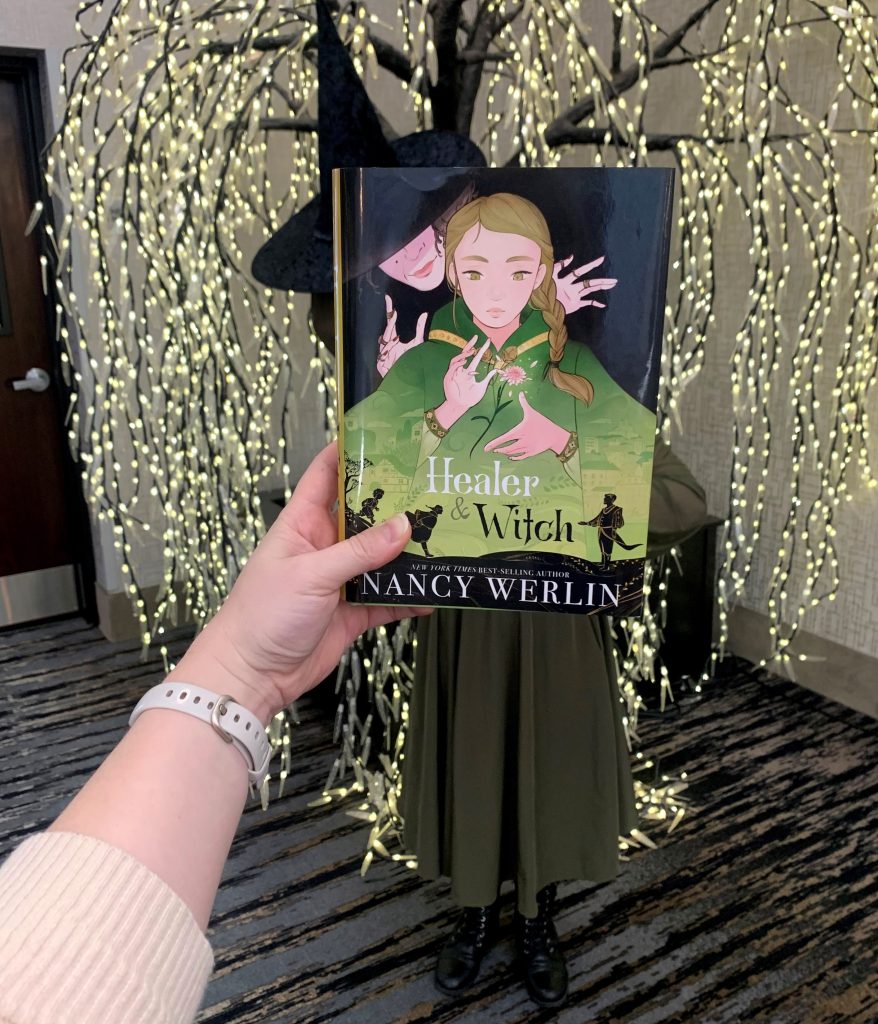
We’ve been at the Nebraska Library Association Conference this week connecting with Nebraska’s librarians and Library staff! Sally Snyder, NLC’s Children and Youth Services Coordinator, also had a table there full of her giveaway books, all available for libraries to take home with them. One of those books is this week’s #BookFace, “Healer & Witch” by Nancy Werlin (Candlewick Press, 2022). Perfect for middle grade readers, this coming-of-age YA novel is a fantasy and historical fiction story all rolled into one. All in all the perfect October read!
“Werlin’s first foray into middle grade is a thrilling and suspenseful experience; there are twisting reveals and adventure aplenty, though the story isn’t afraid to stop for lovely moments of
quiet contemplation and recollection along the way. A budding, respectful romance and hints of deeper powers will have readers hoping for a sequel. It’s well worth joining kind and clever Sylvie on her harrowing journey of discovery.”—Booklist (starred review)
This title comes from our large collection of children’s and young adult books sent to us as review copies from book publishers. When our Children and Young Adult Library Services Coordinator, Sally Snyder, is done with them, the review copies are available for the Library System Directors to distribute to school and public libraries in their systems.
Love this #BookFace & reading? Check out our past #BookFaceFriday photos on the Nebraska Library Commission’s Facebook page!
Posted in Books & Reading, General, Youth Services
Tagged Book Covers, bookface, bookfacefriday, Fantasy, Halloween, Healer & Witch, Historical Fiction, Nancy Werlin, Reading, YA books
Leave a comment
Throwback Thursday: Library and Reading Room, State Industrial School, Kearney
Are you reading this week #ThrowbackThursday?
This 6-1/2″ x 4″ black and white plate from around 1916 shows the library and reading room in the State Industrial School located in Kearney, Nebraska. A number of boys in uniform sit in chairs reading while others look at books in wooden bookcases that line one long wall. The remodeling and refurbishing of the library in the 1915-1916 biennium (at a cost of $287.40) included new bookcases. At the end of the biennium, the collection included “1,080 volumes of choice literature.
This image is published and owned by the Nebraska Library Commission. The collections include material on the history of libraries in the state of Nebraska, items from the 1930s related to the Nebraska Public Library Commission bookmobile, as well as items showcasing the history of Nebraska’s state institutions.
See this collection and many more on the Nebraska Memories archive!
The Nebraska Memories archive is brought to you by the Nebraska Library Commission. If your institution is interested in participating in Nebraska Memories, see http://nlc.nebraska.gov/nebraskamemories/participation.aspx for more information.
#BookFaceFriday “Unthinkable” by Helen Thomson
This #BookFace will blow your mind!
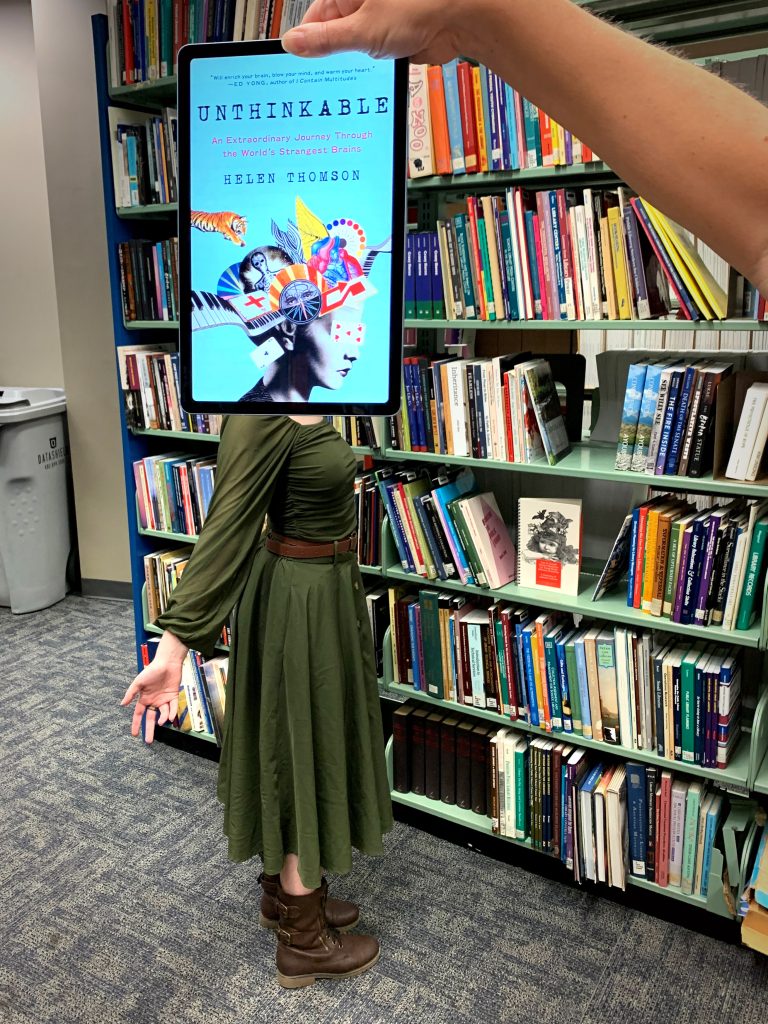
Free your mind, and the rest will follow. If you love learning through reading or just nonfiction books in general check out this week’s #BookFaceFriday, “Unthinkable” by Helen Thomson, it’s a nonfiction journey through some of the biggest mysteries of the human brain. You can find this title as an Audiobook through Nebraska OverDrive Libraries, it’s a part of the “Talk Nerdy to Me” curated collection in Overdrive.
“Thomson has a gift for making the complex and strange understandable and relatable. Oliver Sacks is noted as an inspiration and, indeed, this book will appeal to his many fans.”
—Library Journal (starred review)
Libraries participating in the Nebraska OverDrive Libraries Group currently have access to a shared and growing collection of digital downloadable audiobooks and eBooks. 194 libraries across the state share the Nebraska OverDrive collection of 26,898 audiobooks, 36,794 ebooks, and 5,133 magazines. As an added bonus it includes 130 podcasts that are always available with simultaneous use (SU), as well as SU ebooks and audiobook titles that publishers have made available for a limited time. If you’re a part of it, let your users know about this great title, and if you’re not a member yet, find more information about participating in Nebraska Overdrive Libraries
Love this #BookFace & reading? Check out our past #BookFaceFriday photos on the Nebraska Library Commission’s Facebook page!
Posted in Books & Reading, General
Tagged Book Covers, bookfacefriday, Helen Thomson, libraries, nonfiction, OverDrive, Reading, Unthinkable
Leave a comment
Throwback Thursday: “When the Frost is on the Corn”
Autumn is finally settling in #ThrowbackThursday!
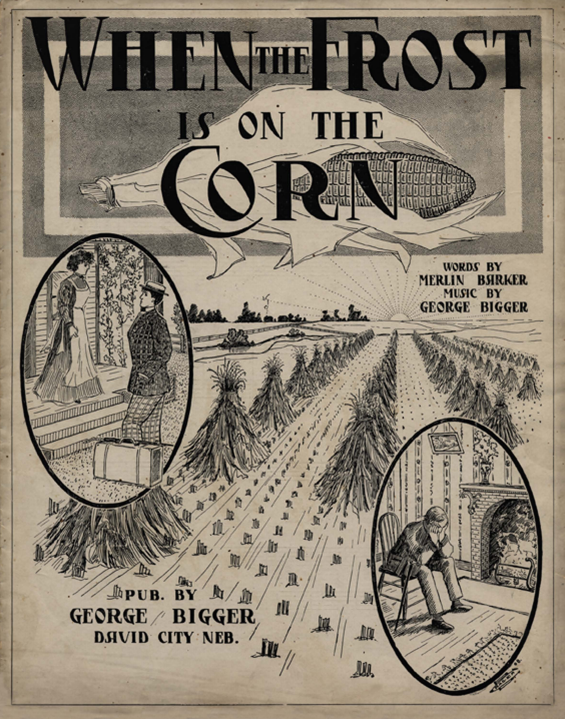
Dated 1908, “When the Frost is on the Corn” is a song written by George Bigger, a barber who lived in David City, Nebraska. The sheet music lists the words as being by Merlin Baker, music by George Bigger, and arrangement by Emery Marshall.
Verse 1:
When the skies are turning gray,
Then my tho’ts begin to stray,
To that home down on the farm where I was born;
And my sweetheart’s face I see,
As I hear her say to me:
“You’ll come back, dear, when the frost is on the corn.”
When the autumn leaves are flutt’ring o’er the meadow,
And the robins for the south begin to fly;
Then in memory I roam back to you, and home, sweet home,
I’ll come back dear, in the happy bye and bye.
When the frost is on the corn,
And from all the autumn morn,
Mem’ries come that call me back, no more to roam;
I will come and see you, dear,
In the fading of the year,
When the frost is on the corn, I’ll come back home.
Verse 2:
Many years have passed away,
Since that happy summer day,
When we parted in the freshness of life’s morn;
And tho’ I am growing old,
Still my heart is never cold;
I’ll come back, dear, when the frost is on the corn.
Time’s cold hand has left the frost upon my forehead,
But in mem’ry still your smiling face I see;
And thro’ all the cruel years, still your voice my fancy hears:
“When the frost is on the corn, come home to me.”
When the frost is on the corn,
And from all the autumn morn,
Mem’ries come that call me back, no more to roam;
I will come and see you, dear,
In the fading of the year,
When the frost is on the corn, I’ll come back home.
This image and musical performance is published and owned by the Polley Music Library (Lincoln City Libraries, Lincoln, Nebraska), which contains just over two hundred fifty pieces of Nebraska sheet music, as well as concert programs, manuscripts, theatre programs, photographs, and other Nebraska memorabilia which features an element of music. You can also listen to a dozen performances of selections from this music collection performed by local musicians.
See this collection and many more on the Nebraska Memories archive!
The Nebraska Memories archive is brought to you by the Nebraska Library Commission. If your institution is interested in participating in Nebraska Memories, see http://nlc.nebraska.gov/nebraskamemories/participation.aspx for more information.
Young Readers Invited to Write to Favorite Authors
FOR IMMEDIATE RELEASE:
October 2, 2024
FOR MORE INFORMATION:
Tessa Timperley
402-471-3434
800-307-2665
Young Readers Invited to Write to Favorite Authors
Young readers in grades 4-12 are invited to write a personal letter to an author for the Nebraska Letters about Literature (LAL) contest, a state reading and writing promotion program. The letter can be to any author (living or dead) from any genre: fiction or nonfiction, contemporary or classic – explaining how that author’s work changed the student’s view of the world. Submissions must be completed online October 1 – December 31, 2024. Nebraska Letters About Literature is coordinated and sponsored by the Nebraska Center for the Book and the Nebraska Library Commission, with support from Lincoln City Libraries, Francie & Finch Bookshop, and Humanities Nebraska.The Nebraska Center for the Book’s panel of judges will select a winner and an honorable mention per competition level (Level I for grades 4-6, Level II for grades 7-8, and Level III for grades 9-12) to be honored in a proclamation-signing ceremony at the state capitol during National Library Week in April 2025. Their winning letters will be placed in the Jane Pope Geske Heritage Room of Nebraska Authors at Bennett Martin Public Library in Lincoln. Nebraska winners and honorable mentions will receive state prizes.
Teachers, librarians, and parents can download the contest guidelines, free teaching materials, information on the online entry system, and past winning letters on the Nebraska Center for the Book website. An informational NCompass Live webinar will air on October 23rd, discussing this year’s contest, the submission process, and judging criteria. For more information contact Nebraska Center for the Book.
The Nebraska Center for the Book is housed at the Nebraska Library Commission and brings together the state’s readers, writers, booksellers, librarians, publishers, printers, educators, and scholars to build the community of the book, supporting programs to celebrate and stimulate public interest in books, reading, and the written word. The Nebraska Center for the Book is supported by the national Center for the Book in the Library of Congress and the Nebraska Library Commission.
As the state library agency, the Nebraska Library Commission is an advocate for the library and information needs of all Nebraskans. The mission of the Library Commission is statewide promotion, development, and coordination of library and information services, “bringing together people and information.”
###
The most up-to-date news releases from the Nebraska Library Commission are always available on the Library Commission Website, http://nlc.nebraska.gov/publications/newsreleases .
#BookFaceFriday “The Miseducation of Cameron Post” by Emily M. Danforth
This #BookFace is outstanding in its field!
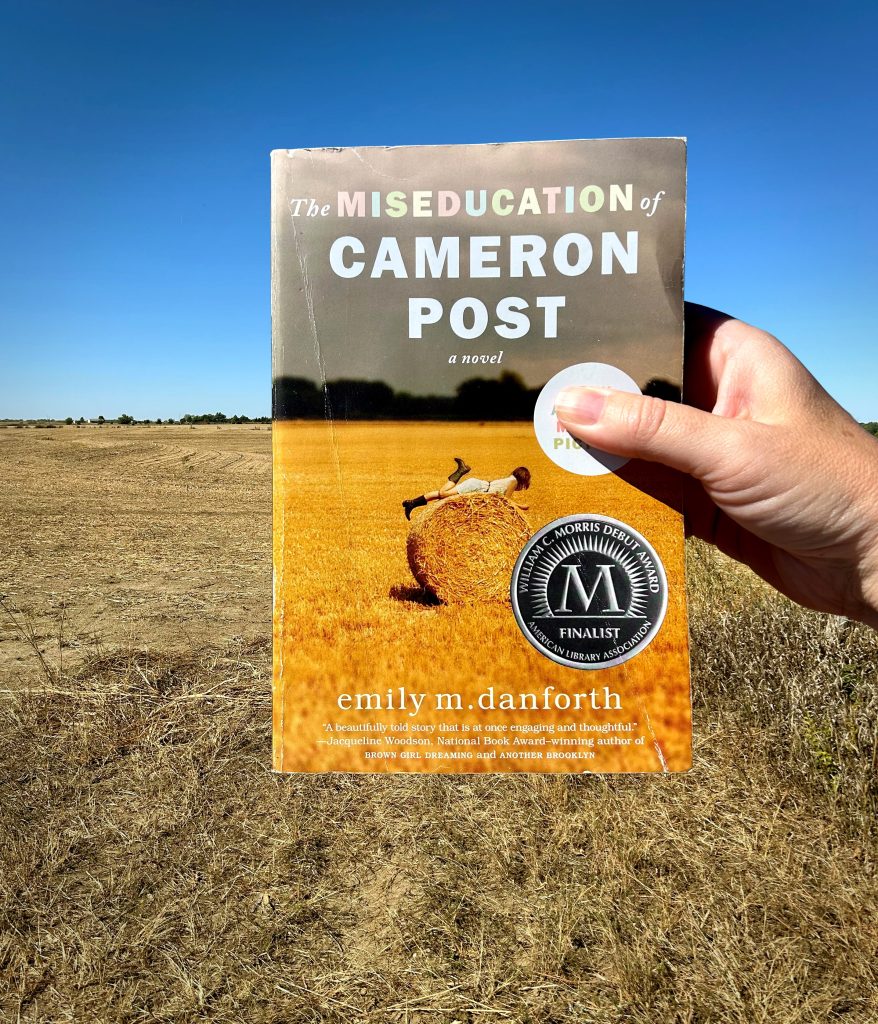
Freed between the lines! That’s the theme of this year’s #BannedBooksWeek. We are celebrating with a banned #BookFace! The Nebraska Library Commission supports readers and the freedom to read so we make sure our various collections reflect that. “The Miseducation of Cameron Post: A Novel” by Emily M. Danforth (Balzer + Bray, 2013) has been banned or challenged in the US since 2014, less than a year after it’s publication, cited for “inappropriate language, not appropriate for middle school age students.” It won The Montana Book Award and was a finalist for both the Morris Award and a Lambda Literary award. Emily Danforth was born in Montana and received her Ph.D in English-Creative Writing from the University of Nebraska-Lincoln! A book is considered challenged when calls are made for it to be banned or removed from the public’s access. This is one of many banned or challenged titles NLC has available in our Book Club Kit Collection, titles like The Perks of Being a Wallflower by Stephen Chbosky, Looking For Alaska by John Green, The Absolutely True Diary of a Part-Time Indian by Sherman Alexie, A Wrinkle in Time by Madeleine L’Engle, Beloved by Toni Morrison, and the Harry Potter Series by J.K. Rowling, just to name a few. This week’s #BookFace and other banned books can be found on the NLC Book Club Kit webpage. This service allows libraries and school librarians to “check out” multiple copies of a book without adding to their permanent collections, or budgets. NLC also has several banned or challenged titles available to our Nebraska OverDrive Libraries.
“This finely crafted, sophisticated coming-of-age debut novel is multilayered, finessing such issues as loss, first love, and friendship. An excellent read for both teens and adults.”
— School Library Journal (starred review)
You can find more information about Banned Books Week and the fight against censorship at ALA.org/advocacy/bbooks! What are you doing to celebrate Banned Books Week? Let us know!
Book Club Kits Rules for Use
- These kits can be checked out by the librarians of Nebraska libraries and media centers.
- Circulation times are flexible and will be based upon availability. There is no standard check-out time for book club kits.
- Please search the collection to select items you wish to borrow and use the REQUEST THIS KIT icon to borrow items.
- Contact the Information Desk at the Library Commission if you have any questions: by phone: 800/307-2665, or by email: Information Services Team
Love this #BookFace & reading? Check out our past #BookFaceFriday photos on the Nebraska Library Commission’s Facebook page!
Posted in Books & Reading, General
Tagged Banned Books Week, Book Club Kits, Book Covers, bookface, bookfacefriday, Lois Lowry, Reading, The Giver
Leave a comment
Throwback Thursday: U.P. Depot and Motor Car, Valley, Nebraska
It’s another #ThrowbackThursday!
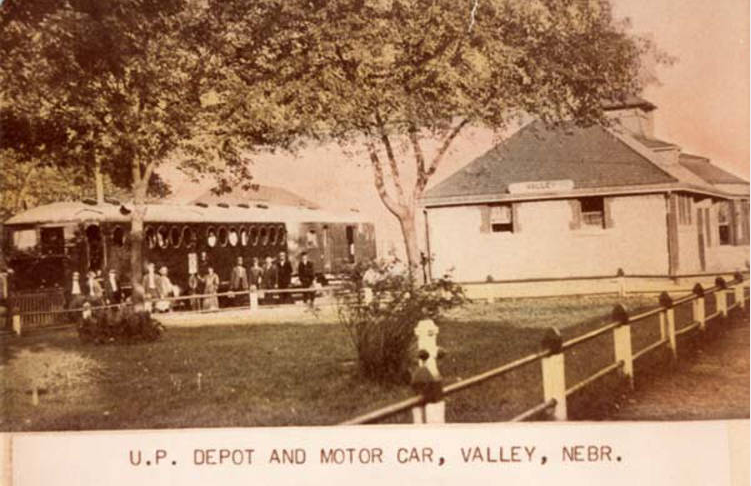
This 5-1/4″ x 3-1/2″ colorized photograph shows the east side of the Valley Union Pacific depot with local passengers boarding the McKeen Motor Car for a trip to Omaha. The luggage car on the end held suitcases, luggage, boxes and mail. The McKeen Motor Car made two trips a day to the city. The car was built in Omaha, in early 1906, at the Union Pacific yards located where the Qwest Center is today. The motor car, invented by William R. McKeen for the U.P., was used to carry passengers. The car ran on gasoline which made it much cheaper than a steam engine. Nicknamed the “knife nose”, the cars were maroon enamel over a steel body. The motor car was discontinued in the mid-1930s and the depot was demolished in the 1980s.
This image is published and owned by the Valley Public Library. The Friends of the Valley Public Library, Valley, Nebraska, have digitized and described a collection of photographs depicting businesses and members of the local population between the late 1800s and 1900s in Valley.
See this collection and many more on the Nebraska Memories archive!
The Nebraska Memories archive is brought to you by the Nebraska Library Commission. If your institution is interested in participating in Nebraska Memories, see http://nlc.nebraska.gov/nebraskamemories/participation.aspx for more information.
NCompass Live: NLC Grants for 2025
Learn more about the NLC Grants for 2025 on this week’s NCompass Live webinar on Wednesday, September 25 at 10am CT.
Nebraska Accredited Public Libraries and State-run Institutions! Do you have an idea for a program or project you would like to see funded? Apply for an NLC Grant!
The Nebraska Library Commission has made funding available for four grants for 2025: Continuing Education & Training, Internship, Library Improvement, and Youth Grants for Excellence. Don’t let your library miss out on these opportunities!
Grant applications for all 2025 NLC grants opened on September 20 and will be due November 15, 2024.
Join Christa Porter, Sally Snyder, and Holli Duggan, from the Nebraska Library Commission’s Library Development Team, as they provide an overview of the grants, including eligibility requirements and grant guidelines, the application process and grant review, timelines and deadlines. They will also share some tips on writing effective grants.
Upcoming NCompass Live shows:
- Oct. 2 – Pretty Sweet Tech: Digital Navigators & Digital Equity in Nebraska
- Oct. 9 – NO NCOMPASS LIVE – ENJOY NLA!
- Oct. 16 – Dragons at the Library: An Exciting New Reading Program
- Oct. 23 – Letters About Literature 2024
- Oct. 30 – Pretty Sweet Tech
- Nov. 6 – Summer Reading Program 2025: Color Our World
- Nov. 13 – Nebraska Open Meetings Act: 2024 Overview and Update
To register for an NCompass Live show, or to listen to recordings of past shows, go to the NCompass Live webpage.
NCompass Live is broadcast live every Wednesday from 10am – 11am Central Time. Convert to your time zone on the Official U.S. Time website.
The show is presented online using the GoTo Webinar online meeting service. Before you attend a session, please see the NLC Online Sessions webpage for detailed information about GoTo Webinar, including system requirements, firewall permissions, and equipment requirements for computer speakers and microphones.
Posted in Books & Reading, Education & Training, General, Grants, Information Resources, Library Management, Now hiring @ your library, Preservation, Programming, Public Library Boards of Trustees, Public Relations, Technology, Youth Services
Tagged Continuing Education, Internship Grants, library improvement gratns, NCompLive, Youth Grants for Excellence
Leave a comment
#BookFaceFriday “Haven’s Wake” by Ladette Randolph & “Hell or High Water” by Joy Castro
When one #BookFace closes, another one opens.
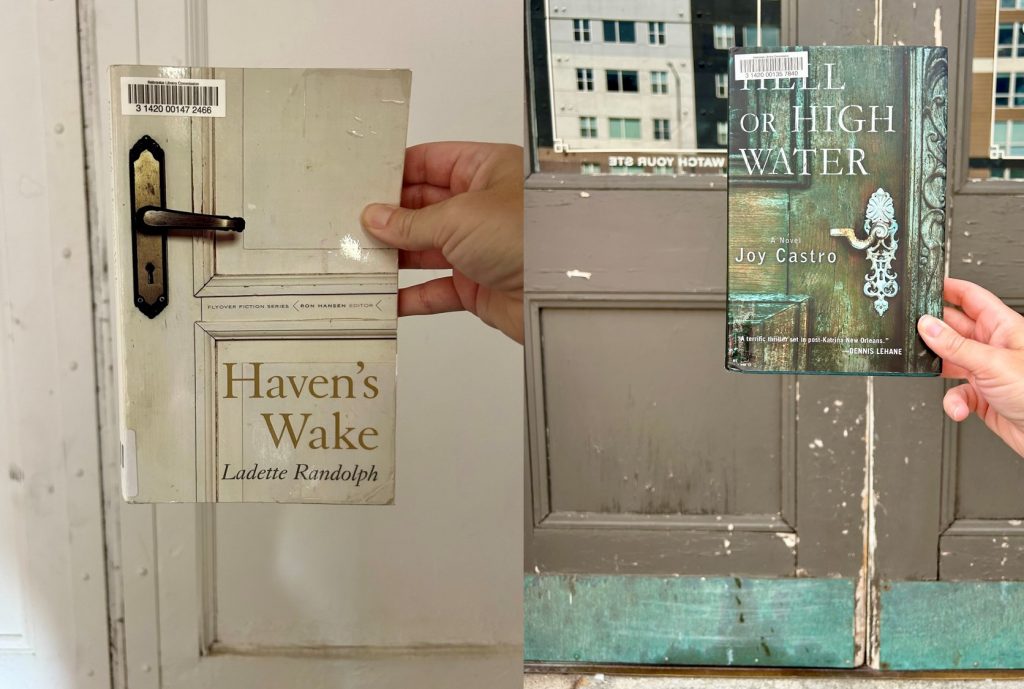
There’s nothing better than supporting Nebraska’s great literary talent by reading their books! This week’s #BookFaceFriday highlights two great Nebraska authors! “Haven’s Wake” by Ladette Randolph and “Hell or High Water” by Joy Castro, both novels are available as Book Club Kits for your library. Find more titles using the Nebraska-Related books located in the Browse Options section of our Book Club Kit Collection which includes fiction, nonfiction, adult, and kids/YA titles. Both “Haven’s Wake” and “Hell or High Water” can also be checked out through Nebraska OverDrive Libraries.
“With prose that vivifies the intricate patchwork of characters and captures the landscape’s simplicity, Haven’s Wake explores ‘the various attempts to explain the unexplainable,’ including family, faith, and death.”
—Katharine Fronk, Booklist Online
“A terrific mystery, but Hell or High Water is more than just a mystery; it’s a heartfelt examination of a second America–poor but undaunted–that was swept under the rug but refuses to stay there . . . I can’t wait to see what Joy Castro does next.”
– Dennis Lehane, New York Times bestselling author of Mystic River
Book Club Kits Rules for Use
- These kits can be checked out by the librarians of Nebraska libraries and media centers.
- Circulation times are flexible and will be based upon availability. There is no standard check-out time for book club kits.
- Please search the collection to select items you wish to borrow and use the REQUEST THIS KIT icon to borrow items.
- Contact the Information Desk at the Library Commission if you have any questions: by phone: 800/307-2665, or by email: Information Services Team
Libraries participating in the Nebraska OverDrive Libraries Group currently have access to a shared and growing collection of digital downloadable audiobooks and eBooks. 194 libraries across the state share the Nebraska OverDrive collection of 26,898 audiobooks, 36,794 ebooks, and 5,133 magazines. As an added bonus it includes 130 podcasts that are always available with simultaneous use (SU), as well as SU ebooks and audiobook titles that publishers have made available for a limited time. If you’re a part of it, let your users know about this great title, and if you’re not a member yet, find more information about participating in Nebraska Overdrive Libraries!
Love this #BookFace & reading? Check out our past #BookFaceFriday photos on the Nebraska Library Commission’s Facebook page!
Throwback Thursday: 1906 Football Team
It’s football season #ThrowbackThursday!
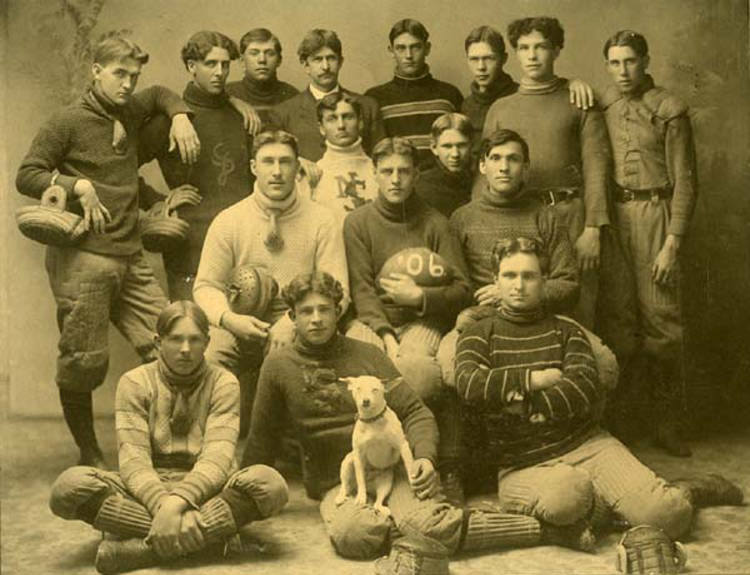
This 9-1/2″ x 7-1/4″ black and white photograph shows the Nebraska State Normal School football team at Kearney, in 1906. It shows sixteen men, most wearing football apparel. One of the seated players holds a football marked ’06 and a white dog in the lap of another. This team compiled a record of 3-4-2 on the season, scoring a total of 28 points. The coach was Wynfred E. Allen.
This image is published and owned by the University of Nebraska at Kearney, Archives, Calvin T. Ryan Library. UNK was founded in 1905 as the Nebraska State Normal School at Kearney, became Nebraska State Teachers College in 1921, was renamed Kearney State College in 1963, and joined the Nebraska University system in 1991. The collection shows faculty, students, buildings and activities from the first dozen years of the school’s existence.
See this collection and many more on the Nebraska Memories archive!
The Nebraska Memories archive is brought to you by the Nebraska Library Commission. If your institution is interested in participating in Nebraska Memories, see http://nlc.nebraska.gov/nebraskamemories/participation.aspx for more information.
Shortlist for 2025 One Book One Nebraska Announced
FOR IMMEDIATE RELEASE:
September 18, 2024
FOR MORE INFORMATION:
Tessa Timperley
402-471-3434
800-307-2665
Shortlist for 2025 One Book One Nebraska Announced
What book will all Nebraskans be encouraged to read in 2025? We will all find out on October 12th at the Nebraska Celebration of Books (N.COB) literary festival. A collection of nonfiction essays about Nebraska, a novel set in 1950’s about personal journeys, a historical fiction novel about the Pacific theater in World War II —all stories with ties to Nebraska—are the finalists for the 2025 One Book One Nebraska statewide reading program. The finalists are: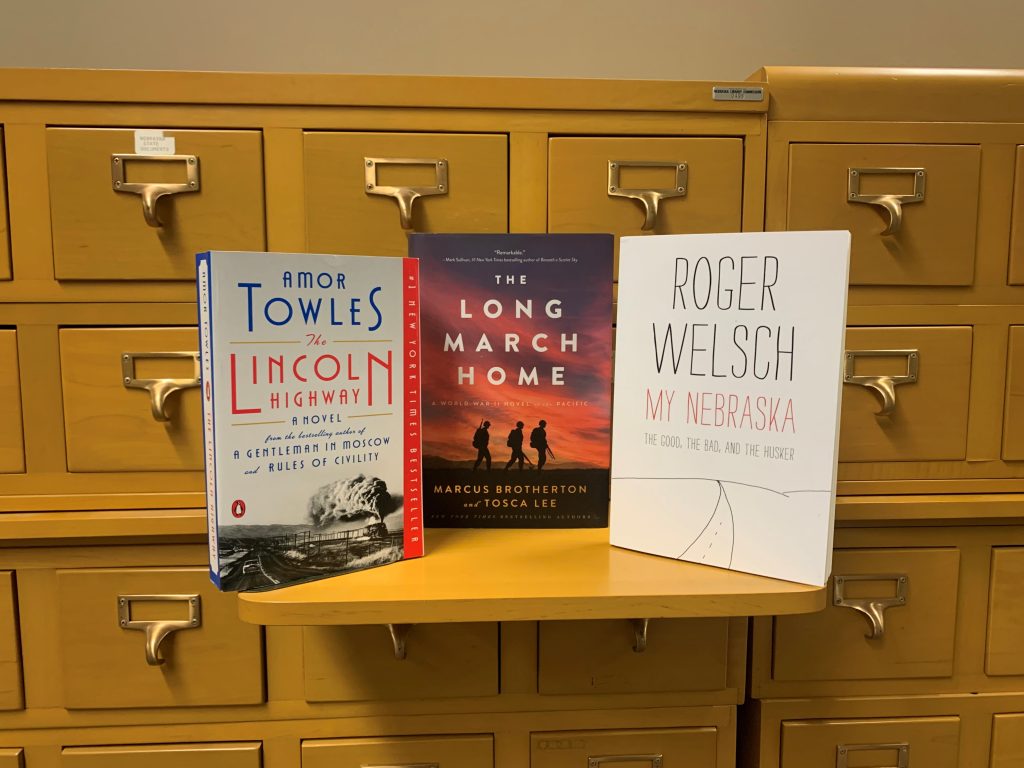
- My Nebraska: The Good, the Bad, and the Husker by Roger Welsch, The Globe Pequot Press, 2006.
- The Lincoln Highway: A Novel by Amor Towles, Viking Press, 2021.
- The Long March Home: A World War II Novel of the Pacific by Marcus Brotherton and Tosca Lee, Revell, 2023.
The One Book One Nebraska reading program is sponsored by the Nebraska Center for the Book, Humanities Nebraska, and the Nebraska Library Commission. It encourages Nebraskans across the state to read and discuss the same book, chosen from books written by Nebraska authors or that have a Nebraska theme or setting. A Nebraska Center for the Book committee selected the three finalists from a list of nineteen titles nominated by Nebraskans. In the coming weeks, Nebraska Center for the Book board members will vote on the 2025 selection.
Nebraskans are invited to take part in the Nebraska Celebration of Books (N.COB) Literary Festival where the choice for the 2025 One Book One Nebraska will be announced. Held on Saturday, October 12th, from 10:00am-5:30pm, in the Regency Suite, Heritage Room, and Swanson Auditorium located on the second floor of the UNL City Campus Union, this event aims to celebrate Nebraska’s literary heritage and contemporary authors. The festival will honor the 20th anniversary of the One Book One Nebraska program with a panel of past authors, in addition it will feature Nebraska authors, a SLAM poetry showcase, book vendors, and presentation of the Nebraska Center for the Book’s Nebraska Book Awards, Mildred Bennett Award and Jane Geske Award.
This year’s One Book One Nebraska selection, Dancing with the Octopus: A Memoir of a Crime by Debora Harding, will be featured with a memoir writing workshop facilitated by Lucy Atkins from Larksong Writers Place. See http://onebook.nebraska.gov or https://www.facebook.com/OneBookOneNebraska for more information about ongoing 2024 One Book One Nebraska activities.
The Nebraska Center for the Book is housed at the Nebraska Library Commission and brings together the state’s readers, writers, booksellers, librarians, publishers, printers, educators, and scholars to build the community of the book, supporting programs to celebrate and stimulate public interest in books, reading, and the written word. The Nebraska Center for the Book is supported by the national Center for the Book in the Library of Congress and the Nebraska Library Commission.
As the state library agency, the Nebraska Library Commission is an advocate for the library and information needs of all Nebraskans. The mission of the Library Commission is statewide promotion, development, and coordination of library and information services, “bringing together people and information.”
###
The most up-to-date news releases from the Nebraska Library Commission are always available on the Library Commission website, http://nlc.nebraska.gov/publications/newsreleases.
